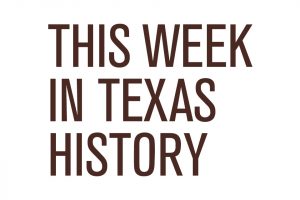When the news of Tom Green’s pending promotion to major general trickled down through the ranks on Feb. 18, 1864, the men of the Texas Cavalry Brigade gave their popular leader three rousing, heartfelt cheers.
Born in Virginia and raised in Tennessee, Green had every reason to stick close to home. But he could not sit idly by while fellow Americans took on a tyrant in Mexico.
Standing an inch or two above six feet and weighing a rock-hard 200 pounds, his size probably caused Gen. Sam Housto...
When the news of Tom Green’s pending promotion to major general trickled down through the ranks on Feb. 18, 1864, the men of the Texas Cavalry Brigade gave their popular leader three rousing, heartfelt cheers.
Born in Virginia and raised in Tennessee, Green had every reason to stick close to home. But he could not sit idly by while fellow Americans took on a tyrant in Mexico.
Standing an inch or two above six feet and weighing a rock-hard 200 pounds, his size probably caused Gen. Sam Houston to assign him to the artillery on that historic afternoon in April 1836. It took a lot of muscle to drag the “Twin Sisters,” a pair of six-pound cannons from the people of Cincinnati, around the battlefield at San Jacinto.
Green and his five comrades were not content to fire the first shot and then let the infantry have all the fun. They pushed and pulled the heavy field pieces to within 70 yards of the Mexican lines and cut loose again.
Green’s heroics did not go unnoticed or unrewarded. The 21 year old private was commissioned a lieutenant soon after the battle and promoted to major two weeks later.
Green was aide-de-camp to Gen. Thomas Rusk, the wounded Houston’s replacement, when he resigned from the army at the end of May and returned to Tennessee. He may have been keeping a promise to his parents, but he could not get Texas out of his system.
Green came back to stay in 1837, settled at La Grange in newly organized Fayette County and began a career in public service as Engrossing Clerk of the House of Representatives in the First Congress of the Texas Republic. He gave politics a try but swore off after a single term in the House and got his old job back.
In 1841 Green was chosen clerk of the Supreme Court, a position he held for the next 20 years. In his spare time, and there was plenty of that, he participated in nine different armed expeditions against hostile Indians and Mexican invaders.
In retaliation for President Mirabeau Lamar’s botched attempt to annex New Mexico, Santa Anna sent troops into Texas twice in 1842. The second time, the French mercenary Gen. Adrian Woll occupied San Antonio for nine days that September and took several hostages with him back across the Rio Grande.
Houston, who had returned to office the previous December, put a trusted ally in charge of 740 volunteers. Tom Green accepted the third link in the chain of command.
Alexander Somervell stalled for time in the hope that the hotter heads would cool off before reaching the river. Two hundred did call it quits on Dec. 11, and another 200 followed Somervell’s lead and turned around a week later.
But the remaining 300 or so insisted upon continuing the pursuit and marched on the border town of Mier. Only by blind luck did Green miss the Christmas Day battle with 2,000 Mexican regulars and the surrender that resulted in cruel captivity.
Three years later, Green was back in Mexico as a company captain in the First Texas Regiment of Mounted Riflemen. Mexicans had made good on their long-standing threat to go to war if the U.S. annexed their breakaway province.
The Texans’ finest and most unforgettable hour came in September 1846. Their man-killer of a task was to drive the enemy from two hills guarding the road to Monterrey.
Green led 300 screaming Texans up Federacion Hill. To the dazed defenders, they were invincible demons from the depths of hell. Every able-bodied Mexican abandoned his post in advance of the onslaught leaving the summit to the attackers.
Green’s tried-and-true tactic worked like a charm again the next morning. This time the enemy stood their ground, but the relentless wave swept them from Independence Hill.
Later that day, Green mounted his third and most memorable charge. In the fight for the Bishop’s Palace, two Texas companies feigned retreat. The Mexicans threw open the gates of the fortress in triumph only to be surprised and overrun by Green and his men.
When push finally came to shove between the states, the 47-year-old colonel commanded one of three Confederate cavalry regiments that tried to conquer New Mexico in the first months of the Civil War. Survivors of the doomed invasion credited the famous Texan for getting them out alive.
Following more heroics in the New Year’s Day 1863 liberation of Galveston, Green was sent to Louisiana. Under his leadership, the First Cavalry Brigade won four major engagements at a cost of 600 casualties compared to 3,000 for the enemy.
On April 12, 1864, the recently promoted major general directed an attack on federal gunboats patrolling the Red River. Green was standing beside his horse on the shore, when he was struck in the head and killed instantly by a cannon shell.
The creation of a new western county a decade after his death provided the perfect opportunity to pay permanent tribute to the fightin’est Texan of them all. Yes, Tom Green County was named for that Tom Green.
Bartee welcomes your comments and questions at barteehaile@gmail.com or P.O. Box 130011, Spring, TX 77393.










